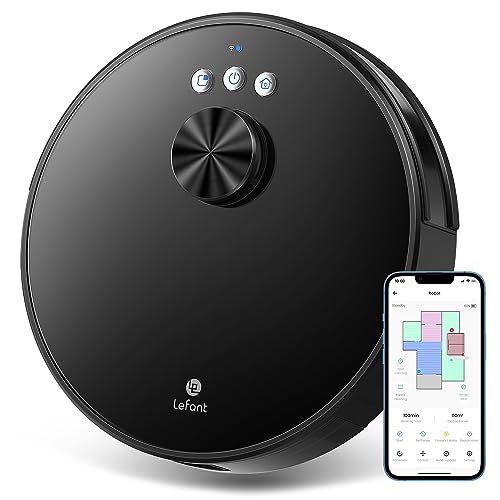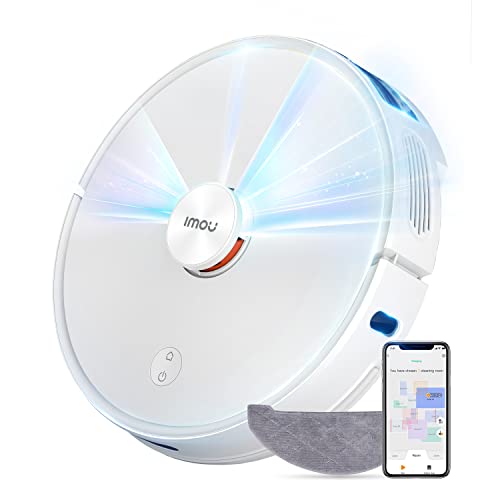The Most Worst Nightmare About Robot Vacuum With Lidar And Camera Be R…
페이지 정보

본문
 Buying a Robot Vacuum With Lidar and Camera
Buying a Robot Vacuum With Lidar and Camera If you're looking for a robot vacuum that has lidar and camera, you have several choices. These robots utilize SLAM to map your space and Lidar for navigation.
If you're looking for a robot vacuum that has lidar and camera, you have several choices. These robots utilize SLAM to map your space and Lidar for navigation.This system of navigation is more effective in avoiding obstacles than gyroscopic and sensor-based systems, which can be sucked into a pile of dog poop or a random wire that is sucked into the wheels.
Obstacle Detection
Cameras and Lidar enable robots to create more detailed maps and to identify and avoid obstacles with greater accuracy. The camera lets robots to view inside closets and cabinets, which is useful for navigating around corners or under furniture.
lidar navigation (light detection and ranger) is a sensor that can send laser beams throughout the room. The time it takes for the laser beams to bounce back off of objects and then return to the sensor, is used to calculate the distance. This is then incorporated into the virtual map of the space, which can be referred to as the robot's movement. Lidar is a better alternative to cameras that provide visual representations of the surroundings. It is not dependent on lighting conditions and can be useful in dark areas.
Some robot vacuums utilize SLAM which stands for simultaneous localization and mapping, to create a precise 3D map of the space and then use that information to navigate in a systematic manner. This is a huge advantage over vacuums that don't make use of SLAM, which can often appear to be ping-ponging across the room or having trouble getting around furniture.
Gyroscopes are another form of robot navigation that uses the rapid spinning motion of the robot to detect distance and location of objects in the room. They are usually less expensive than systems that use lasers to assess the surroundings and generally do a good job of stopping the robot from bumping into things but may not be as effective at forming a complete map of your space, or creating areas of no-go around wires and other dangers.
Some robots that use sensors and cameras to build an 3D model of your home can identify specific obstacles like your dog's poop or the pile of cables that are always under your desk. They can then be programmed to clean around the objects, or more importantly - set clear no-go zones that instruct the robot not to attempt to clean up the mess. You can check the status of your robot’s mapping and no go zones via a smartphone application, making it easier to keep on top of your cleaning.
Mapping
The mapping technology in robot vacuums, similar to that found in self-driving cars and virtual reality games, provides convenience since it allows them to move through your home without human error. Several different navigation methods exist however one that has proven to be particularly effective is Light Detection and Ranging (lidar) mapping.
A robot vacuum equipped with a camera captures images and uses computer vision algorithms for identifying objects such as furniture and walls to create an outline of your living space. This is the primary method of navigation for most robots, but it does have some limitations. It may take some time to map out a space and isn't very useful in low light conditions.
Lidar mapping is faster, more precise and performs well in dark settings. It's also useful for finding drop zones, like steps or other abrupt elevation changes. Drop detection is a standard feature that is found in almost all vacuum lidar robots and prevents your machine from falling down stairs or over other obstacles.
Those who want to move mapping to the next level must look at models that utilize vSLAM or visual simultaneous localization and mapping. This technology makes use of upward-facing cameras to view the ceiling, and other major objects within the space. It is much more effective at navigation through multi-level homes than other navigation methods.
If price isn't a concern, then a robot with this technology would be the best choice for navigation. This is the most advanced and precise option available. It makes it less likely that your robot runs into furniture legs or walls.
The majority of robots that use this navigation system also come with smartphone apps and smart-home integrations, such as Alexa and Siri compatibility. This lets you create "no-go zones" to mark areas where vacuum cleaners should not be in, such as behind a TV screen or desks with cords. The app also shows the cleanroom map of your entire house, so you can check if certain areas aren't being maintained well and make adjustments.
Suction
Many robot vacuums have sensors that aid in navigating the home. Depending on the model, these can include 3D structured light obstacle avoidance technology monocular or binocular vision based obstacle avoidance, or laser navigation. All of these technologies are designed to assist the robot vacuum overcome obstacles and build an outline of the surroundings.
A robot with a camera can provide information about the surroundings that isn't available from other sensors. It can be especially useful in situations where the robot has to distinguish from similar-looking objects like walls or furniture. A camera can help a robot vacuum obstacle avoidance lidar detect small obstacles, like wires or cords that could get tangled in the wheels of the robot vacuum with obstacle avoidance lidar, This Internet site, or be pulled down through its powerful suction.
Some of the top models come with lidars, which create a precise room map. These robots use the map to avoid obstructions and finish the cleaning quicker than less advanced versions.
Lidar cannot detect small obstacles like wires. Therefore, it is important to keep the area free of clutter and cords when using a robot with this feature. Furthermore, if the sensors is obstructed by dust or other debris, it can hinder the performance of the robot.
Although the majority of robot vacuums come with sensors that detect obstacles, they often fall short in detecting fine particles, such as pet hair or fine dust. A robot equipped with cameras built-in can identify these particles more precisely and is a great option for homes with pets or children.
It doesn't matter if you select one equipped with cameras or not, they must all be equipped with drop detectors to prevent them from falling off stairs or other obstacles. These sensors can save you the expense of replacing a robot damaged due to falling off a surface or falling down steps.
In addition to sensors, some premium models of robot vacuums are equipped with cameras for better navigation and mapping. These cameras let you create virtual no-go zones that stop robots from entering areas that have a lot of cables and wiring, which could cause damage.
Battery Life
Robot vacuum cleaners utilize the same technology as self-driving vehicles, planes and virtual reality games. The navigation tech enables these machines to roam throughout your home in complete freedom and to avoid "restricted areas" and even return to their base to recharge their batteries. However, this technology comes at a price -- with models costing between $200 and four figures. To ensure that you get the best value for your money, it's important to set a budget before shopping.
First, decide what you want your robot vacuum to perform. Do you want your robot vacuum to be the primary vacuum cleaner or do you need it to do several tasks (vacuuming mopping, vacuuming, etc.)? After you've decided on your budget, look at features and capabilities.
It is essential that the model you select has the most efficient navigation system and mapping system. Lidar technology is the most efficient method to map your space.
Lidar works by using the low-powered laser to detect light reflections and then create a 3D map of the area. This is significantly more precise than other mapping techniques used by robovacs, like infrared sensors or cameras that depend on physical contact with objects in order to collect data.
The less cluttered your home is, the better your sensor will perform. The clutter can be from shoes, toys and charging cords, as well as loose wires or wires that are loose. These items can interfere with navigation. If a robot vac encounters these obstacles, it's likely to need to spend more time and effort trying to overcome them, which could cause battery life to be shortened and a subpar cleaning.
Certain robot vacuums employ Gyroscopes to avoid bumping into things and can even make a basic map of the space. Advanced systems, such as SLAM (Simultaneous Localization and Mapping), are more expensive but, in most cases, more efficient alternative.
- 이전글You'll Never Guess This Greenpower Electric Scooters's Tricks 24.09.01
- 다음글You'll Be Unable To Guess Replacement Mini Key Fob's Benefits 24.09.01
댓글목록
등록된 댓글이 없습니다.




